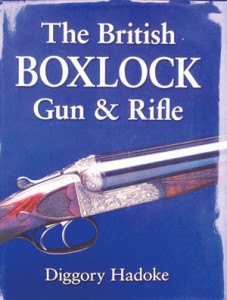Review by Larry S. Sterett | Contributing Editor
 THE BRITISH BOXLOCK GUN & RIFLE by Diggory Hadoke. ©2013.
THE BRITISH BOXLOCK GUN & RIFLE by Diggory Hadoke. ©2013.
Published by the Safari Press
PO Box 3095, Dept. TGM,
Long Beach, CA 90803
Price: $50, plus shipping. Available at most bookstores.
This 224-page hardbound volume is devoted to a subject dear to the heart of any double-barrel shooter and/or collector. It is lavishly illustrated— even the end papers show a scene of W.W. Greener’s gunmakers toiling at their trade at the benches in the old Greener factory. With few exceptions, all the photographs—the majority are in color—were taken by the author; photos not taken by the author are so noted, and credited.
Following a few introductory comments—photo credits, few words of thanks, why write about boxlocks, and What is a Boxlock?—this tome is divided into four parts, from Development to Famous Firms and their Boxlocks, followed by a short section on The 21st Century Boxlock. There is also an index, but no bibliography.
The first part—Development— covers just what the name implies, the development of the Anson and Deeley lock, the basis for the majority of boxlock action rifles and shotguns built today, regardless of the name on them. The advantages of the A&D design can be readily understood after examining the many drawings, cut-away and sectioned photos in this part. (There are no chapters. The topics discussed are printed in a reddish-orange and underscored, such as The groundbreaking patent, The patent drawing, Comparative merits of the boxlock in relation to other actions, and The Dickson round action.) A couple of photos in this part, one a cut-away view of a single-trigger A&D gun from the Wesley Richards collection, and a sectioned double-trigger A&D gun by Darlow are helpful in understanding the Anson Deeley design. The parts are fewer in number and larger than any hammer gun or sidelock, allowing machinery to be used far more extensively.
Topics covered in the section part— Consolidation—range from Quality variations to The demise of the British boxlock, and include such subjects as The boxlock as a double rifle, The boxlock single barrel, and The most successful boxlocks of all time? An interesting table in this section compares the prices of some sidelock, hammer and boxlock model 12-bore shotguns from the late 19th and early 20th centuries. In 1891 the lowest price Hammer Gun by J.V. Needham was three pounds, while the firm’s highest priced Boxlock was 48 pounds. In 1903, W.W. Greener was selling their lowest priced Hammer Gun at nine pounds, nine shillings, and their highest priced Boxlock or Sidelock guns at 73 pounds 10 shillings, or nearly twice what the firm’s highest priced Hammer Gun sold for.
The third Part—The Boxlock Owner’s Guide—is particularly valuable for shotgun collectors and owners of boxlock shotguns and/or rifles. It points out features to look for—wood figures, fit of parts, barrels, inlays, marks of quality, checking for wear and repair, and more. Especially useful are the full-color pages with step-by-step instructions on disassembling the boxlock. Interesting, but not as useful, is the table on the inflated costs of today, compared to a century ago. In 1900 the cost of removing dents from a shotgun barrel ranged from 10 to 15 shillings.
Today, the same job is 80 pounds. In 1900, re-browning of barrels was 10 shillings; today 250 pounds. Stripping and cleaning in 1900 was 5 shillings; today, 200 pounds. Given the price of a new boxlock today, the rebarreling of an older boxlock shotgun is not a viable choice, according to the author.
Part 4—Famous Firms and Their Boxlocks—is a recap of the best known gunmakers of the golden years of shotguns, from Holland & Holland to Hidden Gems. There is even a brief section on The 21st Century Boxlock. (A comment in this section is interesting, and sadly, true. “Today, if you are serious about wanting a Greener boxlock, you need to be in the fortunate position of not needing to enquire as to the price. Suffice to say, it is higher than the standard Purdey or Holland & Holland.”) This is probably the finest book ever written on the subject. It has an index, the illustrations are superb, and the author operates as a British gun dealer in London and Houston. (He was formally a Managing Director of Atkin, Grant & Lang, and has traveled throughout Europe, India, and Asia, in addition to being active in the academic field.) It is the reference text to have on boxlock shotguns and rifles, worthy of space on the bookshelf of any shooter, collector, or dealer in fine firearms.



